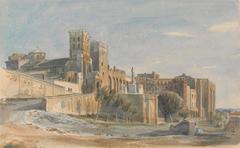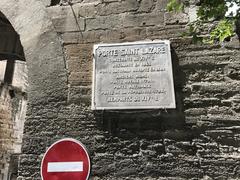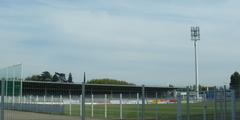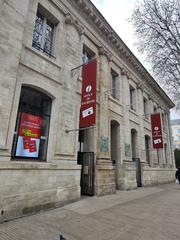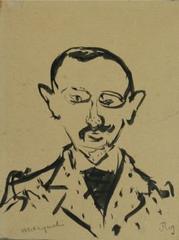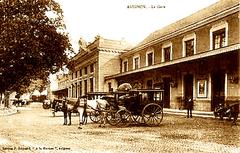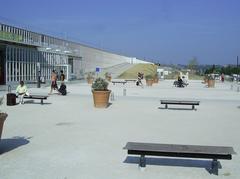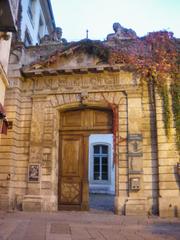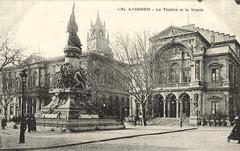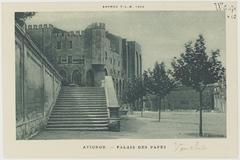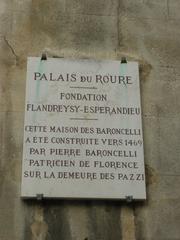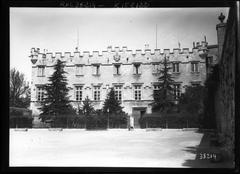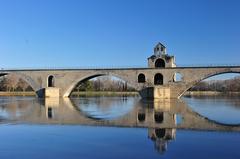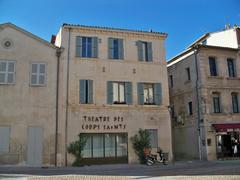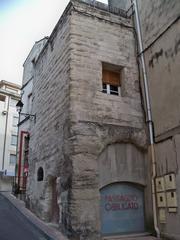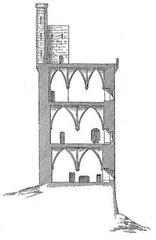Chapelle Saint-Louis d’Avignon: Visiting Hours, Tickets, and Travel Guide
Date: 14/06/2025
Introduction
The Chapelle Saint-Louis d’Avignon, located in the heart of Avignon, France, is a remarkable testament to the city’s vibrant religious, educational, and architectural heritage. Built by the Jesuit order from 1611 to 1619 during the Counter-Reformation, this chapel and its adjacent cloister reflect Jesuit ideals of spiritual contemplation and intellectual rigor. The structure is a masterful blend of late Renaissance and early Baroque styles and remains a treasured site for worship, reflection, and cultural events—especially during the renowned Festival d’Avignon. This comprehensive guide covers everything you need to know for your visit, including opening hours, ticketing, accessibility, historical background, and tips for making the most of nearby Avignon attractions (Avignon-etats-lieux; Grand Avignon Tourisme; Festival d’Avignon).
Table of Contents
- Historical Overview
- Architectural and Artistic Features
- Role in Education and Culture
- Visitor Information: Hours, Tickets, Accessibility
- Preservation and Modern Significance
- Notable Events
- Nearby Attractions
- FAQs
- Travel Tips
- Contact & Further Resources
- Conclusion
- References
Historical Overview
Origins and Construction
Built between 1611 and 1619, the Chapelle Saint-Louis d’Avignon was established by the Jesuit order as part of a college complex, reflecting the Catholic Church’s renewed commitment to education and spiritual formation during the Counter-Reformation. The chapel was dedicated to Saint Louis (King Louis IX), symbolizing both religious devotion and the historic alliance between the French monarchy and the Catholic Church (Avignon-etats-lieux; Avignon Tourisme).
Avignon’s Religious and Political Context
Avignon’s prominence as a religious center was cemented during the Avignon Papacy (1309–1377), when the city hosted seven consecutive popes, leaving a legacy of ecclesiastical architecture and art. The chapel’s founding during the Counter-Reformation further anchored Avignon’s role as a bastion of Catholic renewal and education (TravelPander).
Architectural and Artistic Features
Exterior: Renaissance and Baroque Elements
The façade of the Chapelle Saint-Louis is marked by classical pilasters, a triangular pediment, and subtle Baroque volutes framing the central window—elements characteristic of the Provençal Baroque style, which emphasizes moderation and spiritual focus over ostentation. The design reflects the Jesuit ethos of elegance through restraint (Cityzeum).
Interior: Serenity and Light
Inside, the chapel boasts a single nave illuminated by tall windows that fill the space with natural light, fostering a contemplative atmosphere. Decorative elements are minimal, with the high altar serving as a focal point. The side walls and vaulted ceilings may feature modest frescoes or stucco work, all designed to enhance meditation and spiritual introspection (Cityzeum).
The Cloister
Adjacent to the chapel is the Cloître Saint-Louis, a tranquil courtyard surrounded by arcaded galleries. The cloister was originally used by Jesuit novices for study and reflection, exemplifying monastic architectural traditions with its stone columns and vaulted galleries (Cityzeum).
Role in Education and Culture
The chapel and cloister were integral to the Jesuit college, which offered rigorous education in theology, philosophy, and liberal arts. After the suppression of the Jesuit order in 1762 and the secularization of religious properties during the French Revolution, the site was repurposed for civic uses. In modern times, it has been restored and transformed into a venue for cultural events, including exhibitions and performances, especially during the Festival d’Avignon (JDS).
Visitor Information
Visiting Hours
- Typical Hours: Tuesday to Sunday, 10:00 AM–6:00 PM.
- Closed: Mondays and public holidays.
- Variation: Hours may change during religious services or special events, especially the Festival d’Avignon (early to late July).
Tickets and Admission
- General Admission: Free except during ticketed festival events or special exhibitions.
- Festival Events: Tickets required, typically €10–€30 per event (Festival d’Avignon).
- Guided Tours: Available by appointment; check Grand Avignon Tourisme.
Accessibility
- Wheelchair Access: The site is generally accessible with ramps at the entrance, though some interior areas may have uneven flooring.
- Facilities: No restrooms onsite; public facilities are nearby.
- Assistance: For specific needs, contact the chapel or festival organizers in advance (horairedemesse.fr).
Directions
- Location: Rue du Portail Boquier, 84000 Avignon, France.
- Transport: 10-minute walk from Avignon Centre train station; local buses and taxis available. Parking is nearby but limited in peak seasons (mapcarta.com).
Visitor Etiquette
- Dress modestly (shoulders/knees covered).
- Maintain silence, especially during services.
- Photography is usually permitted outside of religious events; check for restrictions.
Preservation and Modern Significance
Ongoing restoration and conservation efforts ensure the chapel’s architectural integrity and accessibility. It continues to serve as both a place of worship and a cultural venue, hosting art exhibitions, concerts, and performances as part of Avignon’s dynamic cultural scene (Avignon-etats-lieux).
Notable Events
The chapel is a key venue during the Festival d’Avignon, one of Europe’s leading performing arts festivals. It also holds a weekly Mass (Thursdays, 18:00) and occasional community events. Its serene cloister and iconic fountain are favored spots for reflection and photography.
Nearby Attractions
Chapelle Saint-Louis’s central location allows easy exploration of Avignon’s other historic landmarks:
- Palais des Papes: A UNESCO World Heritage site.
- Pont Saint-Bénézet: The legendary medieval bridge.
- Place de l’Horloge: The bustling main square.
- Collection Lambert: Contemporary art museum (mapcarta.com).
- Rue des Teinturiers: Picturesque street with historic water wheels.
- Île Piot: Riverside island for relaxation.
FAQs
Q: What are the standard visiting hours?
A: Tuesday to Sunday, 10:00 AM–6:00 PM, with variations during services and festival periods.
Q: Is admission free?
A: Yes, except for ticketed festival events or special exhibitions.
Q: Is the chapel wheelchair accessible?
A: Generally yes, but some areas may be challenging; contact in advance for details.
Q: Are guided tours available?
A: Yes, by appointment via the tourism office.
Q: Can I attend Mass?
A: Weekly Mass is held on Thursdays at 18:00.
Q: Is photography allowed?
A: Yes, except during services or events when restrictions apply.
Travel Tips
- Best Time to Visit: Early mornings or late afternoons for fewer crowds; avoid festival peak times if seeking quiet.
- Language: French is primary; English is widely spoken in tourist areas.
- Weather: Summers are hot; bring water and sun protection.
- Safety: Standard precautions apply.
Contact & Further Resources
- Address: Rue du Portail Boquier, 84000 Avignon, France
- Phone: +33 (0)4 90 27 66 50
- Tourism Office: Grand Avignon Tourisme
- Mass Times: horairedemesse.fr
- Festival Events: Festival d’Avignon
Conclusion
The Chapelle Saint-Louis d’Avignon is a hidden gem for visitors seeking a blend of spiritual ambiance, historic architecture, and contemporary culture. Its serene cloister, refined Renaissance-Baroque design, and vibrant role in the Festival d’Avignon make it a highlight of any Avignon itinerary. Be sure to check current visiting hours and event schedules, respect the chapel’s etiquette, and explore the surrounding historic sites for a richer understanding of Avignon’s unique heritage.
For more travel tips and the latest updates, download the Audiala app, browse our related posts, and follow us on social media.

